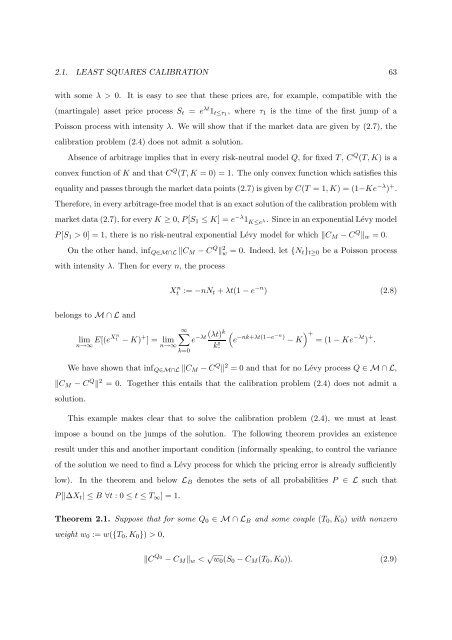Processus de Lévy en Finance - Laboratoire de Probabilités et ...
Processus de Lévy en Finance - Laboratoire de Probabilités et ...
Processus de Lévy en Finance - Laboratoire de Probabilités et ...
You also want an ePaper? Increase the reach of your titles
YUMPU automatically turns print PDFs into web optimized ePapers that Google loves.
2.1. LEAST SQUARES CALIBRATION 63<br />
with some λ > 0. It is easy to see that these prices are, for example, compatible with the<br />
(martingale) ass<strong>et</strong> price process S t = e λt 1 t≤τ1 , where τ 1 is the time of the first jump of a<br />
Poisson process with int<strong>en</strong>sity λ. We will show that if the mark<strong>et</strong> data are giv<strong>en</strong> by (2.7), the<br />
calibration problem (2.4) does not admit a solution.<br />
Abs<strong>en</strong>ce of arbitrage implies that in every risk-neutral mo<strong>de</strong>l Q, for fixed T , C Q (T, K) is a<br />
convex function of K and that C Q (T, K = 0) = 1. The only convex function which satisfies this<br />
equality and passes through the mark<strong>et</strong> data points (2.7) is giv<strong>en</strong> by C(T = 1, K) = (1−Ke −λ ) + .<br />
Therefore, in every arbitrage-free mo<strong>de</strong>l that is an exact solution of the calibration problem with<br />
mark<strong>et</strong> data (2.7), for every K ≥ 0, P [S 1 ≤ K] = e −λ 1 K≤e λ. Since in an expon<strong>en</strong>tial Lévy mo<strong>de</strong>l<br />
P [S 1 > 0] = 1, there is no risk-neutral expon<strong>en</strong>tial Lévy mo<strong>de</strong>l for which ‖C M − C Q ‖ w = 0.<br />
On the other hand, inf Q∈M∩L ‖C M − C Q ‖ 2 w = 0. In<strong>de</strong>ed, l<strong>et</strong> {N t } t≥0 be a Poisson process<br />
with int<strong>en</strong>sity λ. Th<strong>en</strong> for every n, the process<br />
X n t := −nN t + λt(1 − e −n ) (2.8)<br />
belongs to M ∩ L and<br />
lim<br />
n→∞ E[(eXn t<br />
− K) + ] = lim<br />
∞∑<br />
n→∞<br />
k=0<br />
(<br />
−λt (λt)k<br />
+<br />
e e −nk+λt(1−e−n) − K)<br />
= (1 − Ke −λt ) + .<br />
k!<br />
We have shown that inf Q∈M∩L ‖C M − C Q ‖ 2 = 0 and that for no Lévy process Q ∈ M ∩ L,<br />
‖C M − C Q ‖ 2 = 0. Tog<strong>et</strong>her this <strong>en</strong>tails that the calibration problem (2.4) does not admit a<br />
solution.<br />
This example makes clear that to solve the calibration problem (2.4), we must at least<br />
impose a bound on the jumps of the solution. The following theorem provi<strong>de</strong>s an exist<strong>en</strong>ce<br />
result un<strong>de</strong>r this and another important condition (informally speaking, to control the variance<br />
of the solution we need to find a Lévy process for which the pricing error is already suffici<strong>en</strong>tly<br />
low). In the theorem and below L B <strong>de</strong>notes the s<strong>et</strong>s of all probabilities P ∈ L such that<br />
P [|∆X t | ≤ B ∀t : 0 ≤ t ≤ T ∞ ] = 1.<br />
Theorem 2.1. Suppose that for some Q 0 ∈ M ∩ L B and some couple (T 0 , K 0 ) with nonzero<br />
weight w 0 := w({T 0 , K 0 }) > 0,<br />
‖C Q 0<br />
− C M ‖ w < √ w 0 (S 0 − C M (T 0 , K 0 )). (2.9)
















